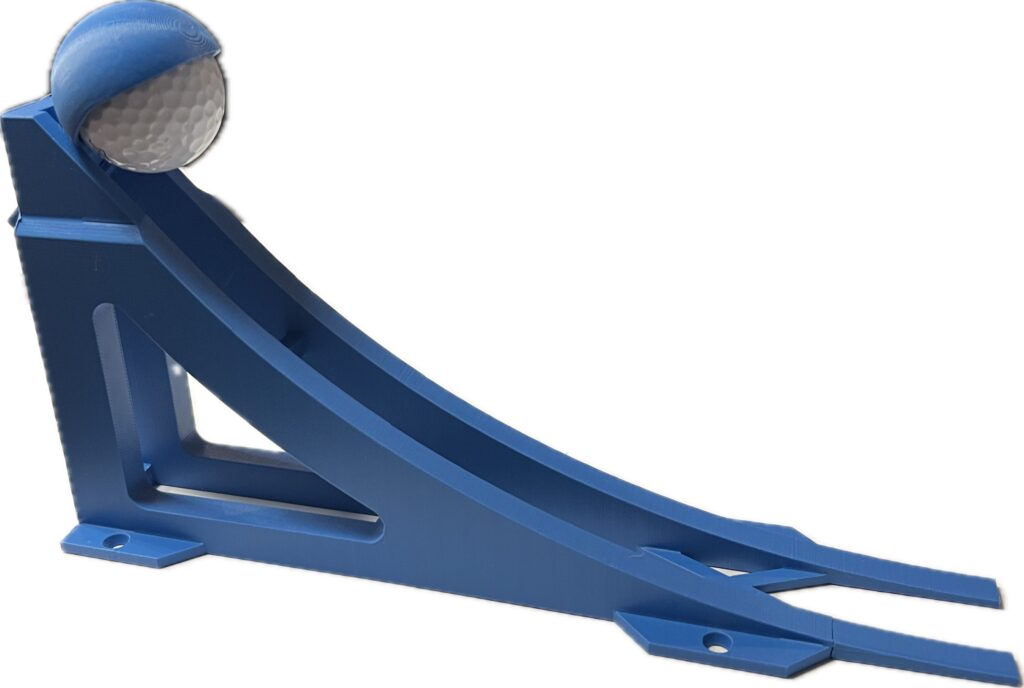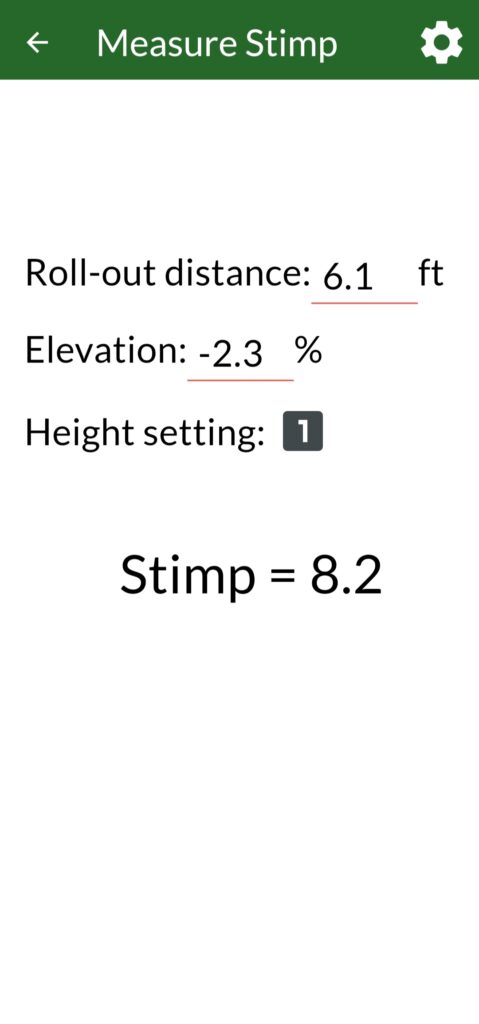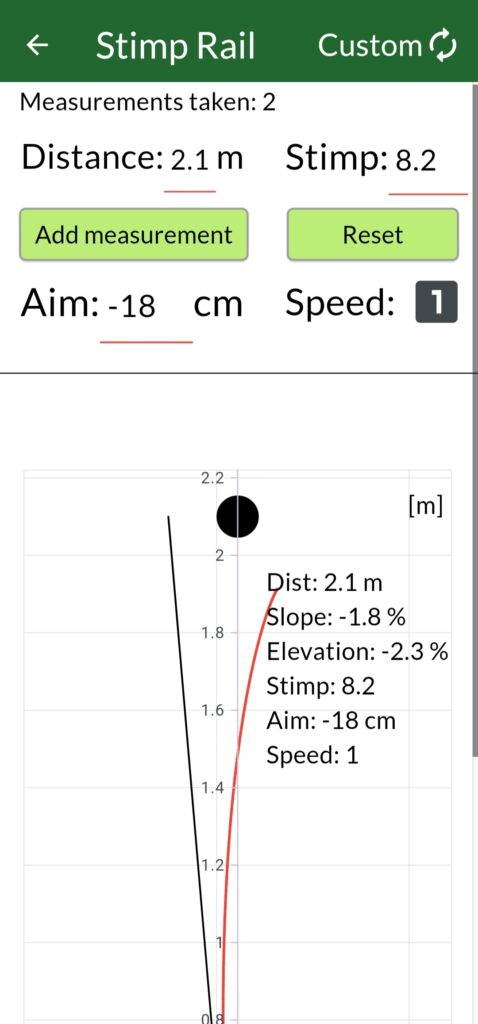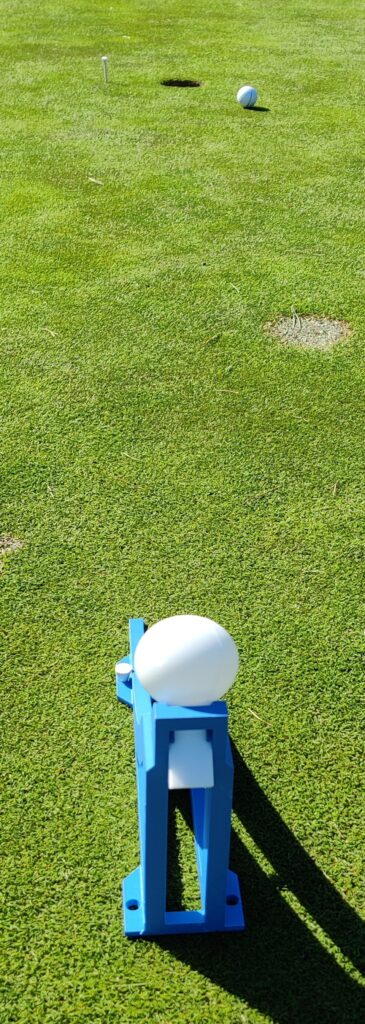In order to read greens correctly there must be a measurement for the green speed. The industry standard for measuring this goes back to the invention of the first stimpmeter back in the 1930’s by Edward Stimpson and the design was later updated back in the 1970’s by the USGA technical department (USGA, 2012). The Stimp Rail is a newly developed alternative which has been designed to increase the accuracy for measuring the stimp of the green.
Firstly, this is how the stimpmeter works. There is an extruded aluminium bar with a v-groove of 145° that guides the ball. At 76 cm there is a notch where the ball is placed. The size of the notch releases the ball when the aluminium bar is inclined to 20°. When the ball is released from the above conditions, the horizontal speed of the ball when contact with the green has been calculated to 1.83 m/s (Holmes, 1986). By then measuring the roll-out distance in feet for multiple rounds, the stimp is determined.
A few problems arise when measuring green speeds with this approach. For starters, as the ball is launched downwards by 20° it begins it’s path on the green while severely bouncing. This causes an unnecessary uncertainty in the measuring process. Furthermore, since the release work by manually raising the aluminium bar until the ball starts rolling, the speed depends on both the user’s speed and reaction time. For example, assuming the user increase the stimpmeter with 2 cm/s and have a reaction time of 0.5 s, this gives a new speed of the ball of 1.86 m/s following Holmes’ calculations. On Tour level greens of stimp 12 that speed difference of 0.03 m/s will give a new higher stimp reading of 12.4. For different users it is therefore likely that different stimp will be measured on the same surface.
With the Stimp Rail, the design mitigate the major contributors to inaccurate green speed readings from the stimpmeter. Instead of launching the ball downwards with 20°, it launches it perfectly horizontal with zero fall distance. This means that it can be released on a hard surface with pure initial roll (seen in video below). Additionally, the release mechanism eliminates most of the user variability. The release mechanism is a spoon like design that grabs the ball. By putting pressure on the sides of the spoon contraption the ball rolls out consistently with no added energy from the user. In laboratory testing the range of the exit velocities with the Stimp Rail is within a ±0.005 m/s tolerance. In comparison to the above case with the stimpmeter, the measured value with the Stimp Rail is no more than 12.06. The viewed dispersion created by the Stimp Rail when it is rolling out 3.6 m (12 feet) will be a equivalent of a band smaller than 4 cm. From a usage perspective it is also easier to use the Stimp Rail as loading and then release is done within a moments notice. Compared to very carefully and slowly raising the stimpmeter in order to reduce the user induced error.
The Stimp Rail will be available in two sizes. One smaller model and one larger model where the key difference is the initial speeds that can be generated. With the larger model there are 4 height settings which gives speeds corresponding to different factors of the definition of stimp. For stimp 12 this is how it will work. The first and lowest setting takes it 6 feet, the second setting takes it 8 feet, third setting takes it 10 feet and 12 feet for the highest setting where the stimp is defined. The smaller Stimp Rail only has the lowest setting which will roll out half of the distance of the stimp. This however makes it very portable.

The conversion of roll-out distance to stimp. It works by multiplying roll-out distance in feet to the stimp conversion factor.
| Height setting | Stimp conversion factor |
| 1 | 3 |
| 2 | 2 |
| 3 | 1.5 |
| 4 | 1.2 |
| 5 | 1 |
Within tGAT there are two pages dedicated to the Stimp Rail. In the first page it is possible to calculate the stimp by measuring the roll-out in centimeter or feet from a specified height setting and for a given elevation (seen in Figure 2).

The second page dedicated to the Stimp Rail you can manually aim the Stimp Rail on a breaking putt, input the 4 green reading parameters and then see the prediction for the roll from the Stimp Rail from a specified height setting (seen in Figure 3).

The result after rolling the putt with the Stimp Rail is seen in Figure 4.

Available for purchase soon!
References
Holmes, B. (1986). Dialog concerning the Stimpmeter. The Physics Teacher, 24(7), 401-404. https://doi.org/10.1119/1.2342065
USGA. (2012). Stimpmeter instruction booklet. USGA. https://www.usga.org/content/dam/usga/pdf/imported/StimpmeterBookletFINAL.pdf

One thought on “Stimp Rail”